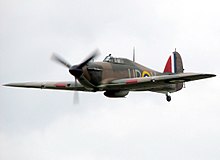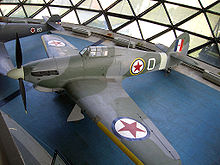Hawker Hurricane
| Hawker Hurricane | |
|---|---|
 Hawker Hurricane Mk I 2006 |
|
| Type: | Fighter plane |
| Design country: | |
| Manufacturer: | |
| First flight: |
November 6, 1935 |
| Commissioning: |
1937 |
| Production time: |
1937-1944 |
| Number of pieces: |
14,533 |
The Hawker Hurricane was a British fighter aircraft from the Second World War . The Hawker Aircraft Ltd. The engine designed was built more than 14,000 times from 1936 to 1944.
The approximately 500 hurricanes delivered by September 1939 formed the backbone of the British fighter pilot's associations when the war broke out. During the Battle of Britain in the late summer and autumn of 1940, the fighter pilot who fought Royal Air Force (RAF) over southern England against the German Luftwaffe . Two thirds of the young pilots flew the robust and reliable Hawker Hurricane, which was overshadowed by the well-known newer Supermarine Spitfire . In 1940, the Hurricane accounted for 55% of British aerial victories.
history
Under the direction of chief designer Sydney Camm , Hawker had been working on a new monoplane fighter since 1933 without a tender . The first detailed drawings in January 1934 met with too little enthusiasm from the Ministry of Aviation to commission a prototype. The refinement of the project, whose outwardly biggest change was a retractable landing gear , was therefore continued on a private initiative. After tests with a wind tunnel model, the ministry ordered a prototype in September 1934, which took off for the first time on November 6, 1935.
The fast fighter was very well received by the RAF and as early as July 1936 600 of the Hurricane named type were ordered to replace the obsolete double-decker fighters of the RAF with their fixed landing gear as quickly as possible. The first production machine Hurricane I finally flew on October 12, 1937.
construction
In terms of construction, the new Hawker-Jäger was well-tried: the hull and surfaces consisted of a tubular steel frame as a load-bearing component, as well as ribs and frames sawn and laminated from plywood, most of which were covered with fabric or planked with balsa wood (shaping component). Even then, this construction method no longer corresponded to the latest state of the art - which consisted of a metal-clad mixed metal structure steel / aluminum with the increasing use of geodetic elements - but made the rapid series production of the Hurricane possible. Small wood and metal processing companies in particular produced the individual parts in a decentralized manner in a manufacturing style. The canopy was also created in this style: a frame welded from angle iron with flat glass panes, later made from Plexiglas to reduce weight, manufactured by small businesses. At the time of the heavy bombing raids on the island in 1940/41, these production conditions were an advantage in terms of armaments strategy. Arms and engines, on the other hand, were manufactured in industrial centers. Final assembly took place in the Hawker works.
It was not until 1939 that the fabric-covered wings were replaced by sheet-metal panels; the surfaces were interchangeable and so all aircraft were gradually converted during the Battle of Britain. The sheet metal-clad wings were only designed as tubular frames up to the landing gear connections, while the outer surfaces were made in a modern shell construction.
Armament and motorization

The Hawker Hurricane was first with eight Browning machine guns of the caliber .303 British (7.7 mm) armed. The stable low-wing aircraft with retractable landing gear was powered by a 1030 hp Rolls-Royce Merlin II engine that acted on a rigid two-bladed propeller . At the beginning of 1939 the equally powerful Merlin III was installed, which drove a more efficient, constant-speed controllable pitch propeller with three blades.
In order to increase the performance of the Hurricane, especially the top speed and rate of climb, the Mk.II version received the more powerful Merlin-XX engine with a two-stage charger and an output of 1300 hp.
The first of the Hurricane Mk.IIA, which is around 20 km / h faster, were delivered in the fall of 1940. In this series, new wings were also used, which were designed to carry drop loads or additional tanks. At the same time, the aircraft received an elongated fuselage. With the Mk.IIBc, the wing armament was increased to twelve Browning MG .
However, tests had shown that armament with on-board cannons was more effective than with MG, so the Mk.IIC version, released in 1941, received four 20 mm Hispano-Suiza automatic cannons . Since the hurricane as a hunter fell behind its opponents as the war progressed, the developers focused primarily on their deep attack qualities.
This led in 1942 to the variant Mk.IID, heavy with two 40-mm cannons under the wings as attack aircraft was used for tank hunting.
A version first called Mk.IIE, then Mk.IV, powered by a Rolls-Royce Merlin 24 or 27 engine with 1620 hp, could optionally be equipped with heavy cannons, bombs or rockets. All hurricanes used in desert regions received special sand filters, which, however, significantly reduced the engine output and thus the speed. For use on aircraft carriers by the Fleet Air Arm (FAA), various variants have been provided with catch hooks for use on aircraft carriers and auxiliary carriers . The Hurricane again benefited from its structure, in which the shaping parts could be replaced to reduce weight. In total, over 14,000 hurricanes were built, many of them under license abroad. 2952 machines were delivered to the Soviet air force from September 1941 .
In order to provide effective airborne fighters for the convoys to the sea and to replace the outdated Sea Gladiator , around 800 hurricans of the series Mk.IA to C, IIB and Mk.XIIA made in Canada were converted to Sea Hurricane. They were fitted with catapult coils or catch hooks, either on so-called CAM ships or on aircraft carriers.
The hurricane in historical review
The stability of the fuselage and the structure was ensured during the entire production of the prototype by a combination of load-bearing and shaping parts. This made the Hurricane less susceptible to explosive projectiles than its counterparts with a load-bearing outer shell. Its modular structure made it possible to retrofit an armored seat, an armored bulkhead to the front and an armored floor.
Self-sealing fuel tanks were not available in 1940. Although the Hurricane had an extinguishing device for the engine compartment, the aircraft was practically lost in an engine fire, as the structure - made of oil-soaked plywood to protect against moisture - immediately caught fire. These shortcomings could never really be remedied. To further reduce weight, the on-board machine guns or machine guns were intended exclusively for wing assembly, since the installation of synchronized on-board weapons that allow firing through the propeller circle was not intended. These were therefore outside the propeller circle and were fired at the same time. If weapons failed on one side, the machine quickly went into a tailspin when firing due to the different size recoils .
Compared to the Spitfire, the Hurricane was judged to be less good as an interceptor, despite its great performance. British propaganda puffed up the Spitfire Mk.II as a guarantee of victory. Their known weaknesses were understandably ignored. This was helped by the fact that the introduction of the Spitfire Mk.II coincided with the already noticeable change in favor of British air defense during the Battle of Britain.
commitment
Shortly after the beginning of the Second World War, the later more powerful Mk.I variant with a three-bladed propeller was delivered to the units. But even this variant was only able to hold its own against the German Messerschmitt Bf 109 , which it encountered over France in the spring of 1940. At the beginning of August 1940, 32 fighter squadrons were equipped with the Hurricane, only 19 with the Spitfire. During the Battle of Britain , the Hurricane pilots scored a large part of the British kills, and in 1940 not a few fighter pilots preferred the slower and more agile Hurricane to the faster and better rising, but more bombardment-sensitive Spitfire. Hurricane units also achieved great success in the defense of Malta and over North Africa, where they already proved themselves in their new role as fighter-bombers . Armed with two heavy 40mm cannons, Hurricane even successfully hunted down tanks. Here, too, the Hawker construction proved to be an excellent weapon platform. It was also hurricanes with which Allied pilots first used rockets against earth targets in 1942. Other areas of application were photo reconnaissance and night hunting. As early as the fall of 1940, hurricanes began to hunt at twilight and at night, and this continued to a notable extent until 1943.
In February 1941, the first use of airborne Sea Hurricane took place with the 804th Squadron. The aircraft were launched from CAM ships with a catapult and had to return to land bases after the deployment. If this was not possible, the pilot had to jump off the parachute or make an emergency landing. In both cases, the mission ended with the loss of the aircraft. On August 3, 1941, a German Fw 200 long-range reconnaissance aircraft was shot down for the first time using a “Catafighter” launched by the “HMS Maplin” . In March 1941, the 880th Squadron commissioned its first Sea Hurricane equipped with a hook for the carrier application. They were used for the first time in July from the aircraft carrier Furious against the polar sea port of Petsamo . In the following course of the war, the Sea Hurricane was also used in the Mediterranean and Atlantic. The last Sea Hurricane was delivered in August 1943.
In addition to the Royal Air Force and Royal Navy of the motherland, Hurricane also flew in associations of the British overseas territories and air forces of other countries:
- Egypt (from 1941: 7 Hurricane I, from 1943: 52 Hurricane II)
- Australia (1 Hurricane I)
- Belgium (30 Hurricane I, 6 Hurricane IIc)
- Greece (30 Hurricane I, 1 Hurricane II)
- Finland (12 Hurricane I, 1 Hurricane IIb)
- France (4 squadrons of the air force of the " France libre ")
- India (about 370 in total in the battles against Japan )
- Iran (1 Hurricane I from 1939, 36 Hurricane II from 1946)
- Ireland (11 Hurricane I, 8 Hurricane II, 1 Hurricane X)
- Yugoslavia (24 Hurricane I)
- Canada (72 Hurricane I, 1 Hurricane IIc, 401 Hurricane XII, 50 Hurricane XIIa; 524 in total)
- Netherlands (from 1942: 24 Hurricane I in Indonesia)
- Norway (9 Hurricane I, 14 Hurricane IIb)
- Portugal (135 Hurricane II from 1943 to 1952)
- Romania (15 Hurricane I)
- Soviet Union (2952 in total, including 2776 Hurricane II)
- South Africa (31 Hurricane I, 43 Hurricane II)
- Turkey (35 Hurricane I, 129 Hurricane II)
Poland had ordered 15 Hurricane I to equip a hunting squadron. The aircraft were completed and given Polish national emblems , but could not be delivered before the German attack on Poland . These machines were then delivered to Turkey.
There was also fighting between Finnish and Soviet hurricanes. The Soviets were not particularly happy with the hurricane. In the Russian winter there were often engine problems and the pilots considered the aircraft to be underarmed. The 7.7 mm machine guns were therefore occasionally exchanged for 12.7 mm UB machine guns and SchWAK machine cannons. When the clearly superior Bf 109G-6 and Fw 190 came into use on the German side, the Hurricane, equipped with two FAB-100 bombs or six RS-82 missiles, was mainly used as a ground attack aircraft to support the ground forces. Some aircraft were used as night fighters .
tactics
Because the flight performance of the Hurricane was generally worse than that of the Spitfire, the RAF proposed a division of tasks: the Spitfires should attack the escorts of the German bombers, the Hurricans the bombers themselves Close escorts, but in practice it was able to involve most of the Hurricane squadrons in aerial battles before they managed to break through to the bombers. In addition, since the Spitfire squadrons continued to attack bombers when the opportunity arose, this division of tasks was not implemented in the field.
Production numbers
The Hurricane was built in the UK by Hawker, Gloster and Austin Motors. In Canada, construction took place at Canadian Car and Foundry.
| version | Hawker | Gloster | Austin | total |
|---|---|---|---|---|
| Mk I | 1.924 | 1,850 | 3,774 | |
| Mk IIa | 418 | 33 | 451 | |
| Mk IIb | 1,781 | 867 | 300 | 2,948 |
| Mk IIc | 4,711 | 4,711 | ||
| Sea Hurricane Mk IIc | 60 | 60 | ||
| Mk IId | 296 | 296 | ||
| Mk IIe | 270 | 270 | ||
| Mk IV | 524 | 524 | ||
| total | 9,984 | 2,750 | 300 | 13,034 |
| year | Hurricane | Sea hurricane | number |
|---|---|---|---|
| 1938 | 221 | 221 | |
| 1939 | 570 | 570 | |
| 1940 | 2,520 | 2,520 | |
| 1941 | 3,168 | 3,168 | |
| 1942 | 3,066 | 36 | 3,102 |
| 1943 | 2,739 | 24 | 2,763 |
| 1944 | 690 | 690 | |
| total | 12,974 | 60 | 13,034 |
A total of 1,451 hurricans were built in Canada from 1940 to 1943, 1,051 of which were British and 400 Canadian.
Technical specifications
| Parameter | Hawker Hurricane Mk.I | Hawker Hurricane Mk.IIB |
|---|---|---|
| crew | 1 | |
| length | 9.59 m | 9.98 m |
| span | 12.20 m | |
| height | 3.96 m | 3.98 m |
| Wing area | 23.93 m² | |
| Top speed | 511 km / h | 542 km / h at 6700 m |
| Empty mass | 2560 kg | |
| Takeoff mass | 3740 kg | |
| Service ceiling | 10,970 m | 11,000 m |
| Range | approx. 850 km | 752 km |
| Engine | a 12-cylinder V-engine Rolls-Royce Merlin II or III; 1,030 hp (758 kW) | a 12-cylinder V-engine Rolls-Royce Merlin XX 1,280 PS (941 kW) |
| Armament | 8 × MG .303 British | 12 × MG .303 British, 2 × bombs 113 or 227 kg and / or 8 missiles |
See also
literature
- Olaf Groehler : History of the Air War 1910 to 1980. 3rd edition. Military publishing house of the German Democratic Republic, Berlin 1981.
Web links
- Numerous pictures with the paintwork of the hurricanes of various air forces at "WingsPalette" (Russian website, English)
- Interesting marginal information about Dutch hurricanes that were deployed over the Far Eastern theater of war ( Memento from September 25, 2006 in the Internet Archive ) (English)
Individual evidence
- ↑ cf. Olaf Groehler: History of the Air War 1910 to 1980. 3rd edition. Military Publishing House of the German Democratic Republic, Berlin 1981, p. 172.
- ^ Johann Althaus: The real winner in the air battle in 1940. In: welt.de. July 21, 2015. Retrieved August 29, 2017 .
- ↑ a b Public Record Office (National Archives), Kew, stock AVIA 10/311.
- ↑ KJ Meekcombs: The British Air Commission and Lend-Lease. Tunbridge Wells, 2000, p. 52 ff.
- ^ Riccardo Niccoli: Airplanes. The main types of aircraft in the world . Kaiser, Klagenfurt 2000, ISBN 3-7043-2188-5 , p. 116 .




